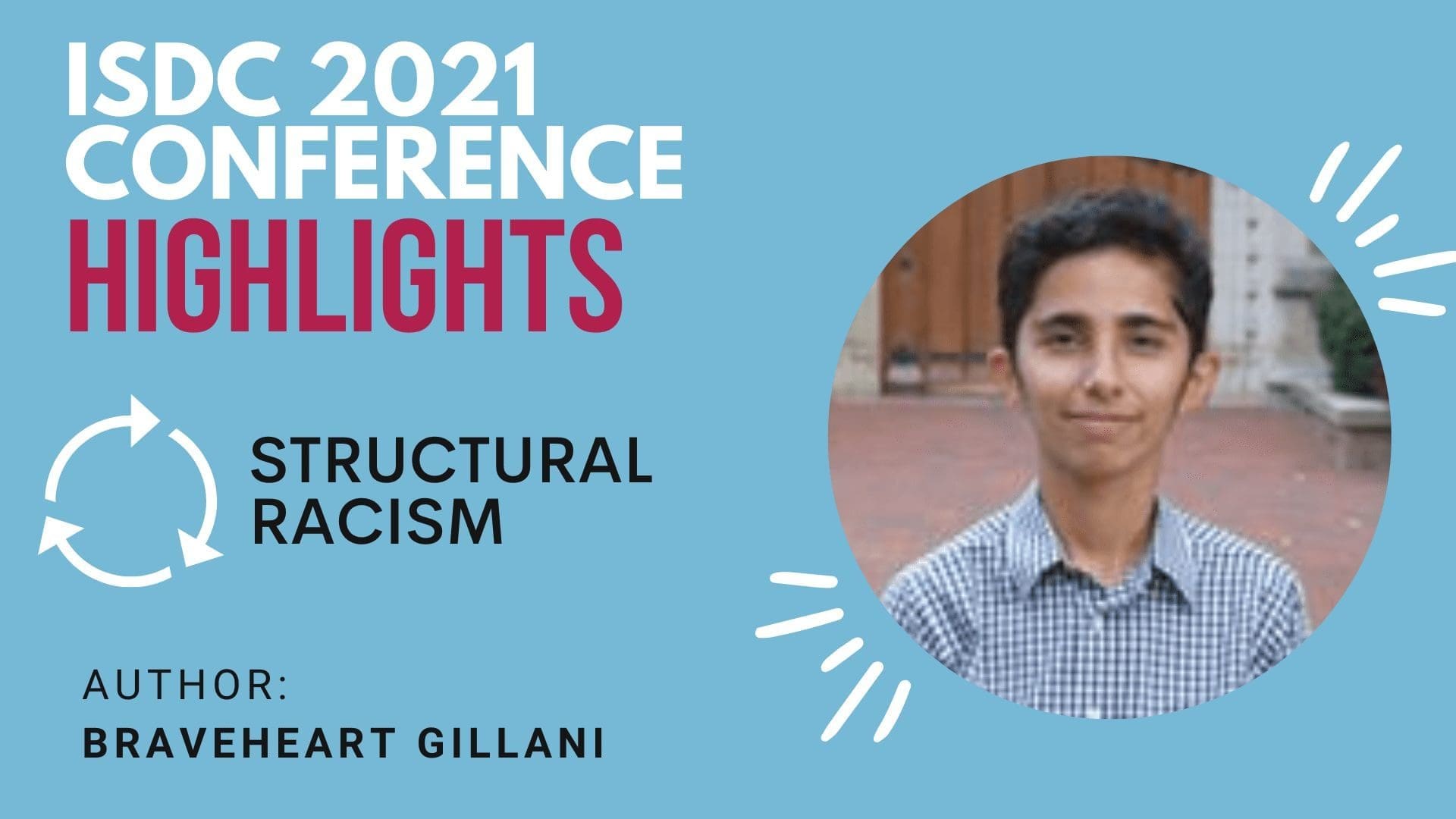ISDC 2021 Highlights: Tackling Structural Racism with Modeling
The International System Dynamics Conference (ISDC) convenes practitioners who demonstrate what’s new and developing in their fields with System Dynamics. This section of the WiSDom Blog, “Conference Highlights,” asks system dynamicists to spotlight key presentations and innovations presented at the conference.
– Conference Highlights Editorial Team: Saras Chung, Will Glass-Husain, Jack Homer, Sara Metcalf, and Remco Peters with coordination by Christine Tang
This highlight by Braveheart Gillani spotlights the work of addressing structural racism with system dynamics
Tackling Structural Racism with Modeling
The brutal murders of George Floyd, Philando Castile, Breonna Taylor and other Black Americans in 2020 caught the attention of people worldwide, highlighting the inequities caused by structural racism. According to the Aspen Institute Roundtable on Community Change, structural racism is defined as “a system in which public policies, institutional practices, cultural representations and other norms work in various, often reinforcing ways to perpetuate racial group inequity.”
These horrifying events happened alongside the COVID-19 pandemic, which also has had a disproportionate impact on communities of color. The Centers for Disease Control and Prevention (CDC) reported that Black people were hospitalized 2.8 times more and died at almost double the rates of whites. Structural racism has been declared a public health crisis by the CDC as well as by some cities, such as Cleveland, and it also threatens access to decent housing, education, and jobs for many people.
The topic of structural racism was first featured in two roundtable sessions a year ago at the 2020 International System Dynamics Conference. During these sessions, members proposed the development of a Special Interest Group (SIG) to build a community of practice for system dynamicists studying this topic. The goal is to build the capacity of SIG members seeking to resolve issues of structural racism using SD. The SIG has held monthly meetings to discuss work in progress, and share resources and concerns. Some of their work was featured at the 2021 conference.
One example of work on structural racism that was presented at ISDC 2021 included Dr. Peter Hovmand’s plenary presentation, Opportunities, Cautions, and Lessons in Humility: Possibilities for Advancing Racial Equity. Hovmand pointed to John Galtung’s work on Structural Violence, which views structural violence operationally as the gap between the oppressive status quo and an individual’s fully potentiated condition. System Dynamics could be used to identify such gaps, accelerate prevention strategies, and increase progress toward more equitable systems. Case Western Reserve University’s Community Based System Dynamics Lab has been addressing structural violence in the contexts of opioid addiction, sexual and gender minority continuity of care, and food and nutrition equity.
In a separate talk on the Impact of Racial Discrimination Across the Life Span, Dr. Hovmand explored how seniors’ theories about their quality of life can vary depending on whether the individuals are Black or White. By using mixed methods and participatory systems mapping with two groups, the study found that Black participants reported greater socio-economic deprivation and lower health-related quality of life than their White counterparts. The two groups generated similar causal loop diagrams, but they described different distributions of resources affecting people’s quality of life.
Finally, in a presentation on Structural Racism and System Dynamics: A Scoping Review, Dr. Irene Headen, Mikayla Branz, and Ellis Ballard identified nine studies that addressed structural racism in a theoretical or an applied way. The six theoretical articles sought problem-based and paradigmatic insights, while the three applied articles sought participatory and dynamic insights.
Dr. Headen also described four essential needs for future System Dynamics work focusing on structural racism:
- Explicitly define time horizons and reference modes to improve problem definition,
- Clearly define and design modeling projects,
- Identify the best sources of structural knowledge and make the best use of system knowledge holders, and
- Think carefully about the origins and reliability of structural knowledge.
ISDC 2021 showcased System Dynamics projects that are addressing structural racism across a range of disciplines. Leaders in this field are demonstrating how we can use the method to untangle the dynamics of structural racism and find ways to root it and its associated inequities out of society. It is exciting to see the insights that can come from applying SD to this complex and critical problem.
Braveheart Gillani
Braveheart.gillani@case.edu
Twitter: @BraveheartGill1
Braveheart Gillani earned his Master’s in Social Work with a specialization in System Dynamics from the Brown School of Social work and is currently working on his Ph.D at the Mandell School of Applied Social Science at Case Western Reserve University. Braveheart’s research and advocacy are focused on sexual and gender minorities, healthy masculinity development, along with issues of racial equity.
ISDC 2021 Highlights: Connecting Perspectives on Gender Dynamics
The International System Dynamics Conference (ISDC) convenes practitioners who demonstrate what’s new and developing in their fields with System Dynamics. This section of the WiSDom Blog, “Conference Highlights,” asks system dynamicists to spotlight key presentations and innovations presented at the conference.
– Conference Highlights Editorial Team: Saras Chung, Will Glass-Husain, Jack Homer, Sara Metcalf, and Remco Peters with coordination by Christine Tang
This highlight by Suzanne Manning spotlights work that demonstrated gender dynamics in System Dynamics modeling. Special thanks to Dr. Sara Metcalf for her editorial support on this post.
Connecting Perspectives on Gender Dynamics
“All that separates, whether of race, class, creed, or sex, is inhuman, and must be overcome” – Kate Sheppard, a leader of the women’s suffrage movement in Aotearoa New Zealand.
Kate was a woman ahead of her time, championing diversity and equality in the nineteenth century. She recognized the need to overcome all forms of discrimination.
As systems scientists, we can use our work to spotlight and disrupt discrimination, or leave these difficult issues aside, losing opportunities for insight. Science is not conducted in a vacuum. The research questions we choose to investigate, variables we choose to model, assumptions underpinning our simulations – these are under our control.
As a first-time attendee at the 2021 International System Dynamics Conference, I was excited to see presenters spotlighting gender discrimination and the emergent system properties of gendered bias.
Two in particular, focused on gender-based violence, one of the biggest issues facing women in the world today. A poster titled It is Not My Fault was presented by Paola García Vázquez, Sandra Vázquez Guerra, Daniela Videa Martínez, and Gloria Pérez Salazar. The authors demonstrated a model of gender-based violence in Mexico, depicting feedback loops that discourage women from reporting by placing them in vulnerable positions without police protection. Their suggested policy intervention was to fund NGOs to provide strong support for women, to which an attendee suggested targeting the “machismo” culture which normalised violence against women instead.
Eduardo De la Vega addressed that culture in his model of violence among adolescents in rural Colombia, suggesting men’s “conquer and domination” tendencies were a key factor for violence on the streets. Both Paola and Eduardo found that focusing on changing men’s attitudes towards violence in general, and against women in particular, could significantly impact violence. In other words, beyond the basic goal of keeping women safe, the models pointed to initiatives that make men safe to be around.
Trust was spotlighted by Sarah Pritchard, Lucy Puckett and Andrew Brown in their Work in Progress presentation titled The Terrible Bargain. By modelling intimate relationships, they showed how men’s respectful behaviour towards women could be a balancing feedback loop that disincentivises unwanted behaviour. I agree – that’s a terrible bargain, for all involved. Their model included the impact of “patriarchal cultural norms.” Targeting societal norms of male behaviour…there’s a theme here.
Another presentation, Sexual and Gender Minority Youth in the Foster Care Model by Dana Prince, Braveheart Gillani and Meagan Ray-Novak, highlighted a critical perspective using minority stress theory. They provided an alternative to linear models that suggest solutions that “blame the victim”, and instead reveal the complex structural issues that lead to multiple levels of stressors for this population. Policy makers need to see this work.
Policy makers should also see how gender dynamics emerge in Fernando Redivo’s model of household level food security in Zambia. Fernando considered a wide range of variables that might influence food security and found that a key factor for supporting food security was to proactively support women who head households. The presence of gendered structural discrimination in Zambian households meant that without extra help, these women were generally not able to sustainably support their families.
Hesam Mahmoudi and Navid Gaffarzadegan also found insights that could help improve women’s lives, by investigating what causes disagreement among physicians. Their paper examined how physicians balance risk and outcomes in their decision processes, noting that some obstetricians overuse Caesarean sections for delivering babies. By choosing a gendered medical example, their analysis leaves the door open for questions about how to model women’s agency and influence in decision-making about delivery, suggesting fruitful avenues for further work.
Parallel to issues of gender, another area for further work was identified by Irene Headen, Mikayla Branz and Ellis Ballard in their review of structural racism research in System Dynamics. They found very few articles in their search. Their recommendation was that models about systemically marginalised people should involve those people in development and analysis.
This advice was on my mind as I attended a presentation by Takuma Ono of work with Rowland Chen, Ivan Taylor, Saroj Koul, and Mia Vogel, on promoting the success of women of color entrepreneurs in the United States. Takuma presented a thorough and high quality model. While this project had not yet involved the subjects of the model directly, Takuma indicated that the next phase of their research would involve reaching out to these women to gather their perspectives.
System Dynamics practitioners are making important contributions to gender analysis, and we might expect to see even more at ISDC2022, since next year’s conference theme is ‘Diversity’. One analysis that I want to keep quiet, though, is from a Work in Progress presentation on gender and the Beergame, by Maria Guadalupe Arias, Juan Pablo Torres, Karla Padilla, and Samuel Madariaga. They compared gender differences while playing a look-and-react Beer Game, and the findings were disputing the literature that says men tend to focus their gaze on a single thing and women look around more. Please don’t share this with my kids – I’ve been telling them that as a mother I have an innate ability to see everything they do!
Suzanne Manning
Suzanne.Manning@esr.cri.nz
Twitter: @slmanning1
Suzanne is passionate about gender equality, education and science. She is currently trying to change the world by working as a social scientist at the Institute of Environmental Science and Research in Aotearoa New Zealand.
ISDC 2021 Highlights: Can Trust be Modeled?
ISDC 2021 Highlights: Can Trust be Modeled?
The International System Dynamics Conference (ISDC) convenes practitioners who demonstrate what’s new and developing in their fields with System Dynamics. This section of the WiSDom Blog, “Conference Highlights,” asks system dynamicists to spotlight key presentations and innovations presented at the conference.
– Conference Highlights Editorial Team: Saras Chung, Will Glass-Husain, Jack Homer, Sara Metcalf, and Remco Peters with coordination by Christine Tang
This highlight by Dr. Pascal Gambardella discusses the use of “trust” in modeling in presentations shared at ISDC.

Can Trust be Modeled?
What we trust, whom we trust, and how we build and maintain trust are central questions for all individuals and organizations. Several of the presentations at the 2021 International System Dynamics Conference (ISDC) grappled with modeling trust.
I had previously given some thought to this topic. At the 2020 ISDC, David Lounsbury and I (the two of us co-leaders of the System Dynamics Society’s Special Interest Group in Psychology) led a workshop on modeling soft constructs such as reputation. We introduced Daniel Diermeier’s “trust radar” factors (transparency, rapport, expertise, and commitment) and used two of them in a model of Diermeier’s “reputational crisis”.
I’m glad to see that other System Dynamics modelers are thinking about this topic as well. The 2021 ISDC presentations I attended addressed trust in the contexts of government, business, and personal relationships. I’ll address each of these.
Trust in Government:
Jorge Valencia and his team modeled the effect of trust in managing COVID-19 in Colombia. Jorge said the government’s blundering actions have caused people to lose trust in its ability to handle the crisis. His team’s approach relied on two models, one qualitative and one quantitative.
The qualitative model was an adaptation of Nobel Prize-winner Elinor Ostrom’s model of trust, in which trust, reputation, reciprocity, and cooperation form a reinforcing loop. Trust in government increases when it communicates the right information to the public. The problem is deciding which information is the most effective: realistic but offering hope. The COVID epidemic offers a perfect example of this dilemma. 
Valencia’s quantitative model uses a Susceptible-Infected-Recovered (SIR) structure with a trust variable. The effectiveness of government mandates is improved when people have some confidence in them and thus cooperate. The resulting reduction in infections and deaths would build even more trust.
Valencia said the Colombian government’s poor response to the pandemic led to protests and worsened the crisis. He asked the audience for help in creating a “trust index” to promote best government practices during a pandemic. I wondered if Diermeier’s “trust radar” might help here.
Trust in Business:
In a talk on structural racism, Peter Hovmand said “collaboration moves at the speed of trust.” This reminded me of Florian Kapmeier and Jeroen Struben’s presentation exploring trust dynamics during early business alliance activities.
Alliances allow businesses to share and combine resources, supporting innovation. However, knowledge exchanges can also cause trouble when one partner fails to fulfill certain obligations under the agreement. How can building trust early in the relationship mitigate this risk?
Kapmeier and Struben’s simulation model includes several major mechanisms and feedback loops. For example, greater management commitment to the alliance can improve partner contributions and interactions, building trust. Also, meeting expectations under the alliance can help to build trust. On the other hand, trust naturally tends to decay over time.
Among the various insights, a counterintuitive one stood out to me. The authors said: “Strategies seeking to build early trust rapidly or to maximize openness may backfire.” This can happen if the partners don’t achieve the high aspirations set during an initial honeymoon period.
Trust in Relationships:
At the Student-Organized Colloquium, Josephine Musango said: “Building trust is key to building relationships for resilience.” I recalled these words when I heard Sarah Pritchard and Lucy Puckett later present on “the terrible bargain” in human relationships. This term, perhaps coined by feminist blogger Melissa McEwan, refers to a situation in which a man’s sexism forces a woman to choose between her dignity and a peaceful relationship. As McEwan puts it, “If I can’t trust you to care when I tell you you’ve hurt me, how can I trust you at all?”
What are the mechanisms that lead to this disparity in trust between men and women who initially respect each other? Pritchard, Puckett, and their co-author Andrew Brown created a causal-loop diagram to explore this question.
In it, we see how a man may respond defensively to potentially helpful feedback from his female partner about his sexist behavior. This antagonistic response may cause her to lose trust and subsequently share less, thus damaging the relationship.
After their fascinating presentation, David Lounsbury and I interviewed Pritchard and Puckett about their work and asked whether this model might apply to other types of relationships and situations.
Sarah Pritchard said, “It’s possible that the model might also apply to other forms of oppression, but we’ve framed it around sexism for now. It’s rooted in situations where there’s an oppressive power imbalance and stereotype threat against giving critical feedback.”
Lucy Puckett added, “It could apply to any sort of relationship in which there is a level of emotional investment, something at stake, that contributes to the power imbalance. Women are in a difficult situation, having to sacrifice their own safety, trust, and authenticity for the sake of maintaining a relationship.”
—
Pascal Gambardella, PhD, started his career as a mathematical physicist and now does research using System Dynamics and Neuro-Semantics. He co-leads the Psychology and Human Behavior SIG of the System Dynamics Society.
Check out the Society’s SIGs – including the Psychology and Human Behavior SIG
Recent Posts
Society Governance Updates
Society Governance Updates Welcome, Allyson! New President Allyson Beall King joined the Policy Council as our 2024 President. Her primary role is as director of the Washington State University School of the Environment, which focuses on regional ecologies and our...
Call for Presenters: Seminar Series
Call for Presenters: Seminar Series We at the System Dynamics Society are continually seeking vibrant and knowledgeable presenters for our ongoing Seminar Series. As we unfold the calendar, there’s always a place for more insights, experiences, and expertise to enrich...
Honoring Excellence: A Glimpse into the Awards of the International System Dynamics Conference
Honoring Excellence: A Glimpse into the Awards of the International System Dynamics Conference The International System Dynamics Conference brings together experts, practitioners, and students to exchange ideas, showcase real-world applications, and celebrate...
Upcoming Events

MIT System Dynamics Seminar | Work Faster? Put in Longer Hours? An Assessment of Reactive Resilience Policies in Supply Chains
Please visit the MIT System Dynamics Seminars page for more information. You are invited to attend a supplemental System Dynamics seminar being held on Tuesday, April 23rd from 12:00-1:00pm EST in the Jay W. Forrester conference room, E62-450, or via...
Recent Business cases
A Design Value Calculator: A System Dynamics Boardgame
A Design Value Calculator: A System Dynamics Boardgame EXECUTIVE Summary Product design is a specific form of complex innovation that touches all areas of an organization’s management. While entrepreneurs recognise the value of design, they often tend to focus...
The World Bank Uses System Dynamics to Identify Root Causes of Poverty
The World Bank Uses System Dynamics to Identify Root Causes of Poverty EXECUTIVE Summary Madagascar has one of the highest poverty rates in the world. In 2022, an astonishingly three out of every four people in Madagascar lived below the poverty line. Poverty has...
Fast-Track Cities Uses System Dynamics to Enhance HIV Care
Fast-Track Cities Uses System Dynamics to Enhance HIV Care EXECUTIVE Summary Low levels of viral suppression at 69% for people with HIV make it hard to believe the 95% target level will be achieved by 2030 in St. Louis, USA. As a solution, Fast-Track Cities-STL opted...








